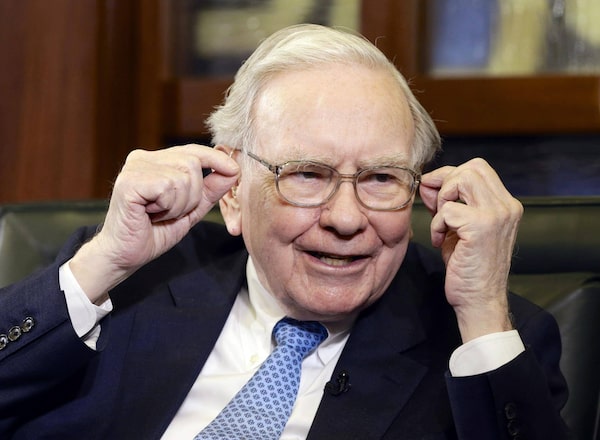
Warren Buffett seeks out businesses that can be easily understood, have strong competitive positions, are attractively priced relative to their intrinsic value and yet may be overlooked by other investors.Nati Harnik
Warren Buffett is likely the world's most famous investor, renowned for taking a common-sense approach in a field that is seemingly anything but sensible, given the markets' recent volatility.
Mr. Buffett's overarching philosophy can be summed up through one of his many well-known quotes: "I don't look to jump over seven-foot bars; I look around for one-foot bars that I can step over."
That said, he seeks out businesses that can be easily understood, have strong competitive positions, are attractively priced relative to their intrinsic value and yet may be overlooked by other investors.
While his principles are easy to grasp, they are difficult to put into practice, says Evan Mancer, chief investment officer with Cardinal Capital Management in Winnipeg, which uses a similar approach.
"A lot of investors can't stick to this philosophy because the market comes at them with a constant stream of information and ideas, often leading them astray," he says.
That doesn't happen to the Oracle of Omaha, as Mr. Buffett is known. The nickname refers to the city he calls home, which is where Berkshire Hathaway Inc., the holding company of which he is chief executive officer and chairman, is based, as well.
"He sticks to what he calls his 'circle of competence,'" Mr. Mancer says. He isn't temped to go into businesses that he doesn't understand well, which "tends to lead him to some pretty well-known stocks." Today he has an estimated net worth of about $85-billion.
His investing approach is hardly novel.
"He came by the way of Benjamin Graham's philosophy, which is deep value," looking for broken businesses that are worth more than what they are trading for on the stock market, says Todd Johnson, a portfolio manager with BCV Asset Management Inc. in Winnipeg. Mr. Graham is often referred to as the father of value investing.
Over the years, Mr. Buffett's strategy has evolved "toward more of an approach that seeks investments with high free cash flow, big brand names that are high-quality and have the ability to grow over time."
Mr. Johnson points to See's Candies Inc., which Berkshire purchased in 1972, as the prototypical example of Mr. Buffett's approach. In writing the preface for a biography on the candy maker, Mr. Buffett pointed out that See's had a quality product and service, as well as strong relationships with its work force and suppliers.
It became a cash-generating machine that allowed Berkshire to invest elsewhere. It also became the model for its investment in other quality companies.
Another key factor for Mr. Buffett is a company's track record, says Susan Latremoille, director of wealth management at the Latremoille Group, Richardson GMP Ltd.
"He typically wouldn't be investing in IPOs, or bitcoin or marijuana stocks, because it takes time to understand these new technologies and businesses," she says.
One factor that gives companies a long, profitable history is a competitive advantage. "He likes companies with an economic moat," says Ms. Latremoille, who is an admitted fan of the Oracle. "The wider the moat, the tougher it is for a competitor to gain market share."
Berkshire Hathaway's investment in Coca-Cola Co. demonstrates this strategy to a T. Mr. Buffett admired Coke's brand-name power and global reach.
"It's very hard to replicate what [Coke] does," Mr. Mancer says. "And he bought at a time when it was expanding internationally, with opportunities in China and India."
Not all of Mr. Buffett's investments turn out well, however. Most notably, Berkshire bought IBM in 2011. In 2017, he admitted he had made an error, telling CNBC that he underestimated the strength of IBM's competitors.
Technology companies typically are not part of Mr. Buffett's "circle of competence," Mr. Mancer notes. But increasingly, IBM, Apple Inc. and other firms with long track records and dominant market positions align with his investment approach.
"In the case of Apple, he's attracted to what a lot of people are attracted to, and that's the growth in services and apps," he says.
Yet Mr. Buffett's strategy involves more than big names with competitive advantages. Fundamental to his success is rigorous research to uncover previously unrecognized upsides to investments.
"He does his homework," Ms. Latremoille says. "That way when he sees the opportunity, he's not afraid to jump in with both feet."
An example is his stake in Bank of America, which he bought in 2011 when it was struggling from the fallout of the financial crisis of 2008-2009.
More recently, he came to the rescue of Canada's Home Capital Group Inc. Investors were spooked over the risk of mortgage defaults, Mr. Mancer says, but Mr. Buffett "saw the primary issues had to do with Home's funding model."
Others worried that Home Capital would not be able to pay interest on its GICs, which it had sold to finance lending. "His insight was that, yes, the debt was a little higher risk than traditional mortgages," Mr. Mancer says, but investors had overestimated the risk of default.
"Home Capital was experiencing what's akin to a run on the bank," Mr. Mancer says. "But when Berkshire Hathaway invests, that worry quickly dissipates."
And this speaks to one quality of Mr. Buffett few others can emulate, Mr. Johnson adds: "Once he gets in, it takes away the idea that a company is in trouble."
Indeed, Berkshire Hathaway, with its enormous amount of cash, sometimes attracts opportunities that few investors see, Mr. Johnson says. It is sometimes able to buy stock at a discount from its listed price, for example.
Also, "deals come across his desk that won't come across other investors' desks," he says, "because of the amount Berkshire can invest."